Abstract
Ingested polyunsaturated fatty acids are postulated to lead to changes in central nervous system activity, presumably by altering the lipid composition of neuronal membranes. In support of this hypothesis, we and other investigators have previously demonstrated cognitive effects in rats fed oils that contain both alpha-linolenic acid (18:3 omega 3) and linoleic acid (18:2 omega 6), with the relative content of alpha-linolenic acid being seen as the critical variable. The present study in rats examined the effects of preparations containing different ratios of highly purified free alpha-linolenic acid to linoleic acid (about 25 mg/kg of body weight daily) on learning performance (Morris water tank), pain thresholds (heated plate), and thermoregulatory control of d-amphetamine-induced hypothermia during 4 weeks of treatment. Preparations with omega 3-to-omega 6 ratios ranging from 1:3.5 to 1:5 (specifically a ratio of 1:4) produced significant favorable effects on all of these variables. Although the specific mode of action remains to be elucidated, these results suggest that such preparations of free fatty acids should be evaluated in the treatment of memory disorders and pain conditions.
Full text
PDF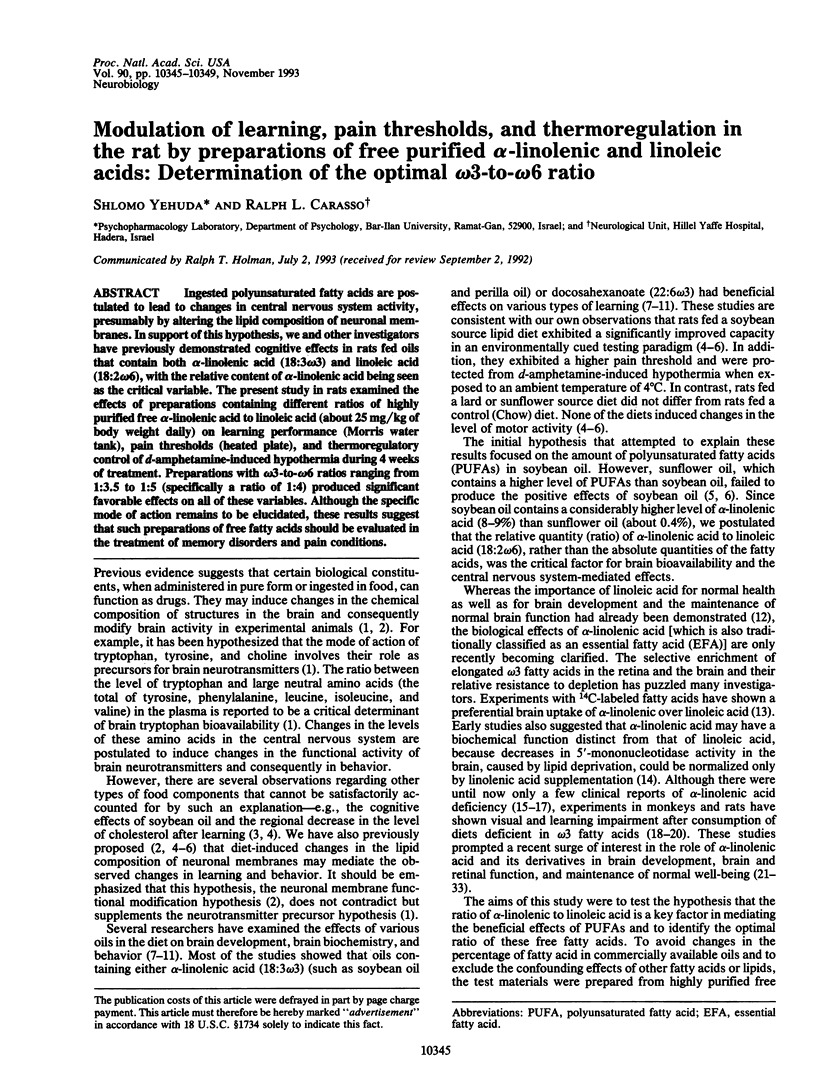
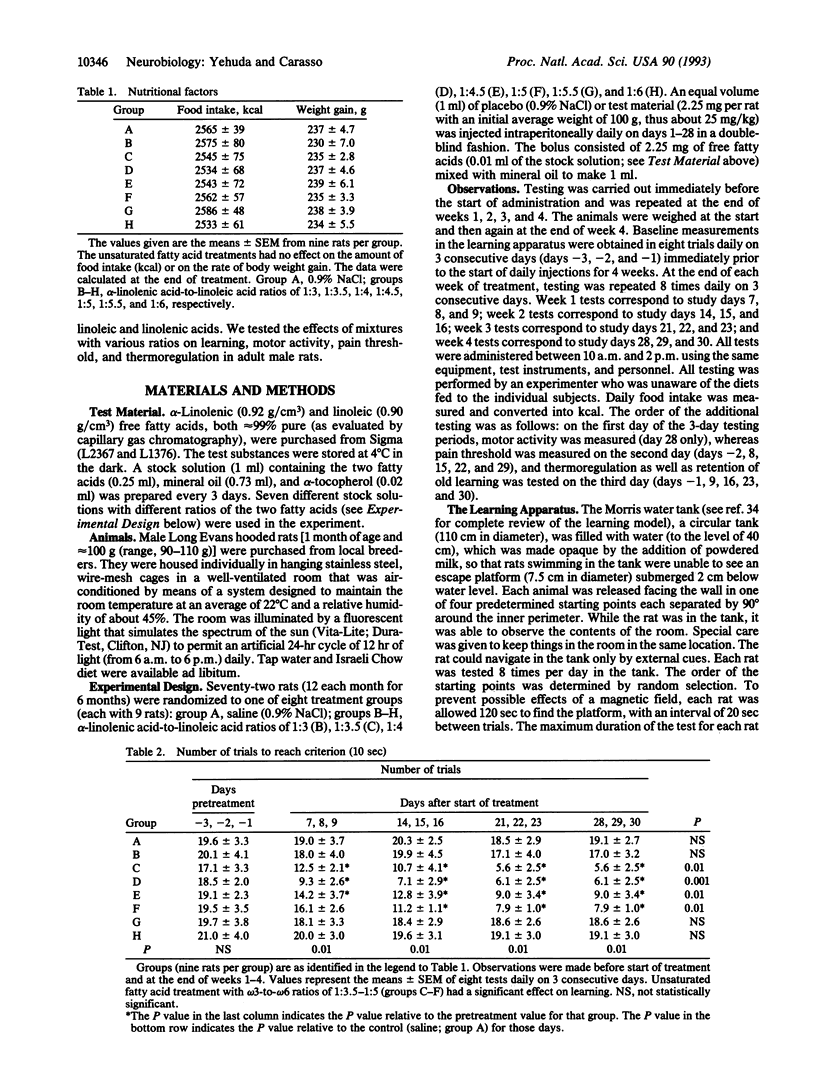
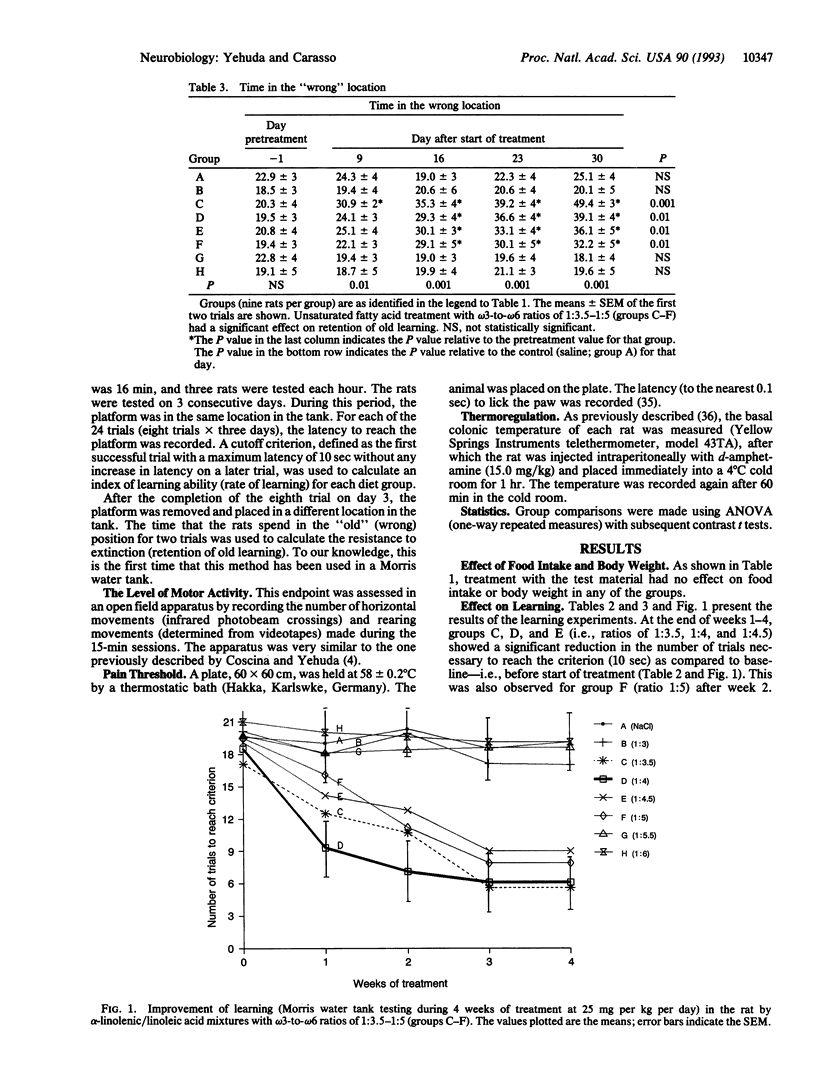
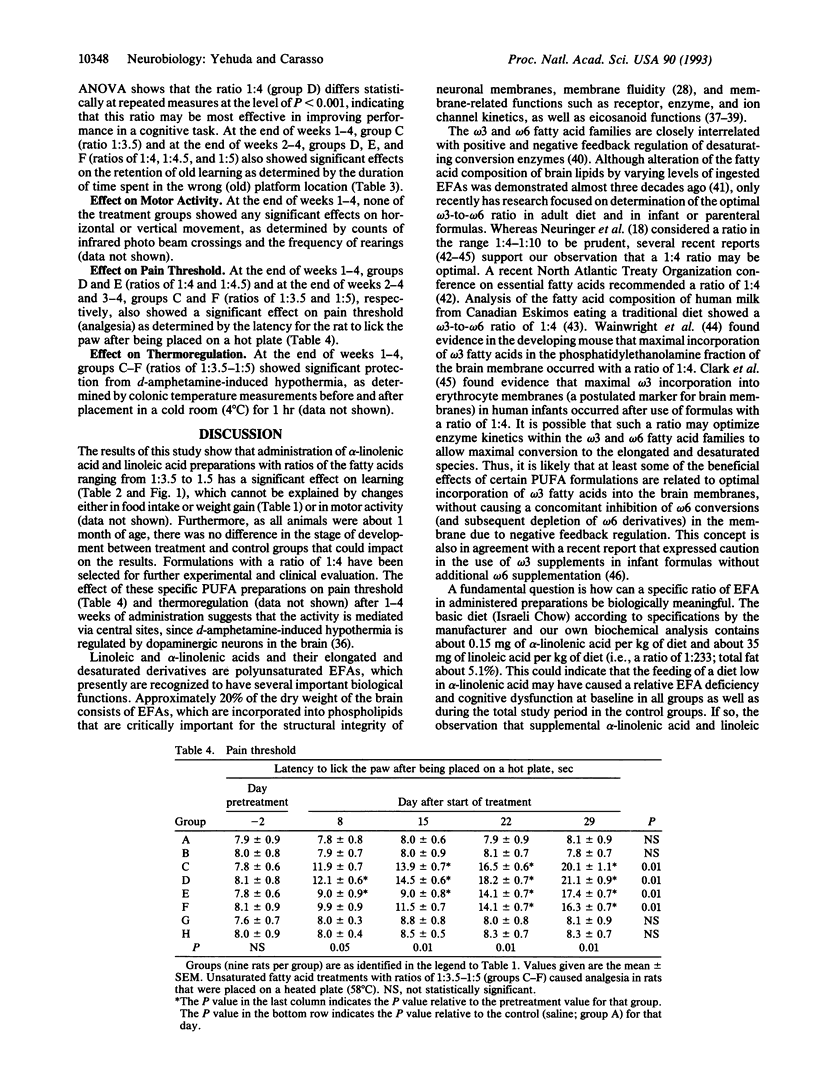
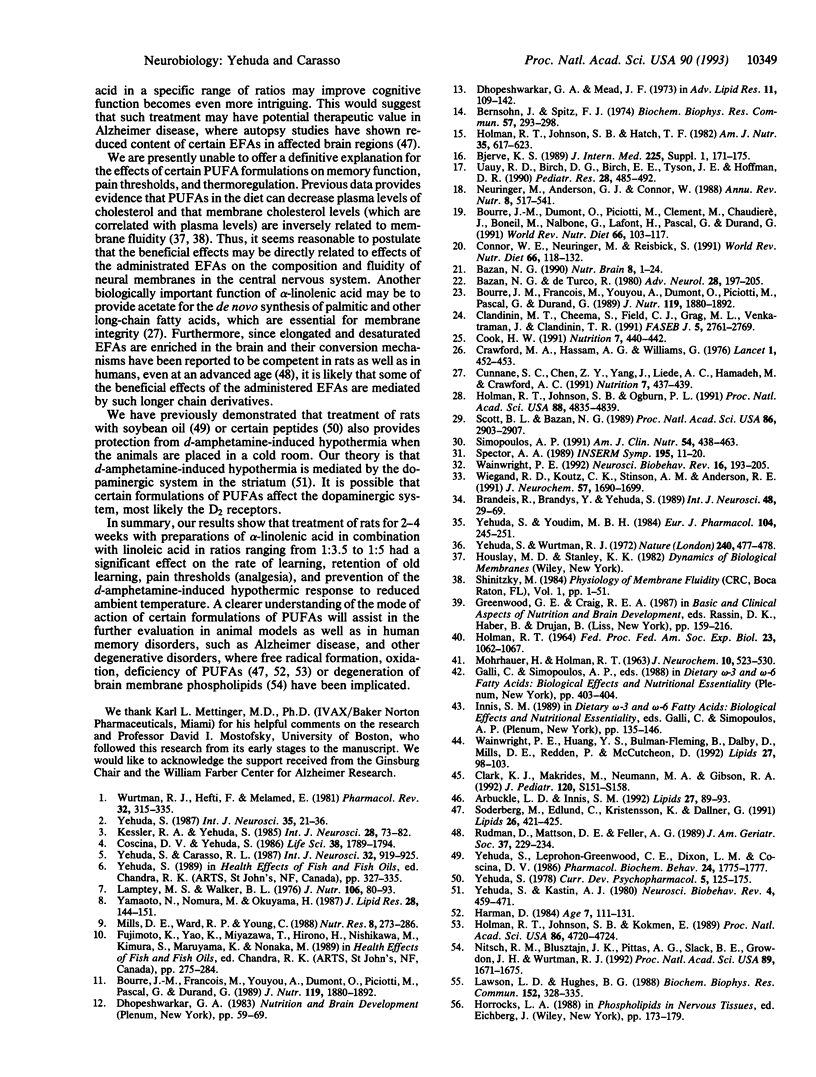
Selected References
These references are in PubMed. This may not be the complete list of references from this article.
- Arbuckle L. D., Innis S. M. Docosahexaenoic acid in developing brain and retina of piglets fed high or low alpha-linolenate formula with and without fish oil. Lipids. 1992 Feb;27(2):89–93. doi: 10.1007/BF02535805. [DOI] [PubMed] [Google Scholar]
- Bazán N. G., Rodríguez de Turco E. B. Membrane lipids in the pathogenesis of brain edema: phospholipids and arachidonic acid, the earliest membrane components changed at the onset of ischemia. Adv Neurol. 1980;28:197–205. [PubMed] [Google Scholar]
- Bernsohn J., Spitz F. J. Linoleic- and linolenic acid dependency of some brain membrane-bound enzymes after lipid deprivation in rats. Biochem Biophys Res Commun. 1974 Mar 15;57(1):293–298. doi: 10.1016/s0006-291x(74)80389-x. [DOI] [PubMed] [Google Scholar]
- Bjerve K. S. n-3 fatty acid deficiency in man. J Intern Med Suppl. 1989;731:171–175. doi: 10.1111/j.1365-2796.1989.tb01451.x. [DOI] [PubMed] [Google Scholar]
- Bourre J. M., Dumont O., Piciotti M., Clément M., Chaudière J., Bonneil M., Nalbone G., Lafont H., Pascal G., Durand G. Essentiality of omega 3 fatty acids for brain structure and function. World Rev Nutr Diet. 1991;66:103–117. doi: 10.1159/000419283. [DOI] [PubMed] [Google Scholar]
- Bourre J. M., Francois M., Youyou A., Dumont O., Piciotti M., Pascal G., Durand G. The effects of dietary alpha-linolenic acid on the composition of nerve membranes, enzymatic activity, amplitude of electrophysiological parameters, resistance to poisons and performance of learning tasks in rats. J Nutr. 1989 Dec;119(12):1880–1892. doi: 10.1093/jn/119.12.1880. [DOI] [PubMed] [Google Scholar]
- Bourre J. M., Francois M., Youyou A., Dumont O., Piciotti M., Pascal G., Durand G. The effects of dietary alpha-linolenic acid on the composition of nerve membranes, enzymatic activity, amplitude of electrophysiological parameters, resistance to poisons and performance of learning tasks in rats. J Nutr. 1989 Dec;119(12):1880–1892. doi: 10.1093/jn/119.12.1880. [DOI] [PubMed] [Google Scholar]
- Brandeis R., Brandys Y., Yehuda S. The use of the Morris Water Maze in the study of memory and learning. Int J Neurosci. 1989 Sep;48(1-2):29–69. doi: 10.3109/00207458909002151. [DOI] [PubMed] [Google Scholar]
- Clandinin M. T., Cheema S., Field C. J., Garg M. L., Venkatraman J., Clandinin T. R. Dietary fat: exogenous determination of membrane structure and cell function. FASEB J. 1991 Oct;5(13):2761–2769. doi: 10.1096/fasebj.5.13.1916101. [DOI] [PubMed] [Google Scholar]
- Clark K. J., Makrides M., Neumann M. A., Gibson R. A. Determination of the optimal ratio of linoleic acid to alpha-linolenic acid in infant formulas. J Pediatr. 1992 Apr;120(4 Pt 2):S151–S158. doi: 10.1016/s0022-3476(05)81250-8. [DOI] [PubMed] [Google Scholar]
- Connor W. E., Neuringer M., Reisbick S. Essentiality of omega 3 fatty acids: evidence from the primate model and implications for human nutrition. World Rev Nutr Diet. 1991;66:118–132. doi: 10.1159/000419284. [DOI] [PubMed] [Google Scholar]
- Cook H. W. Brain metabolism of alpha-linolenic acid during development. Nutrition. 1991 Nov-Dec;7(6):440–442. [PubMed] [Google Scholar]
- Coscina D. V., Yehuda S., Dixon L. M., Kish S. J., Leprohon-Greenwood C. E. Learning is improved by a soybean oil diet in rats. Life Sci. 1986 May 12;38(19):1789–1794. doi: 10.1016/0024-3205(86)90130-x. [DOI] [PubMed] [Google Scholar]
- Crawford M. A., Hassam A. G., Williams G. Essential fatty acids and fetal brain growth. Lancet. 1976 Feb 28;1(7957):452–453. doi: 10.1016/s0140-6736(76)91476-8. [DOI] [PubMed] [Google Scholar]
- Cunnane S. C., Chen Z. Y., Yang J., Liede A. C., Hamadeh M., Crawford M. A. Alpha-linolenic acid in humans: direct functional role or dietary precursor? Nutrition. 1991 Nov-Dec;7(6):437–439. [PubMed] [Google Scholar]
- Dhopeshwarkar G. A., Mead J. F. Uptake and transport of fatty acids into the brain and the role of the blood-brain barrier system. Adv Lipid Res. 1973;11(0):109–142. doi: 10.1016/b978-0-12-024911-4.50010-6. [DOI] [PubMed] [Google Scholar]
- HOLMAN R. T. NUTRITIONAL AND METABOLIC INTERRELATIONSHIPS BETWEEN FATTY ACIDS. Fed Proc. 1964 Sep-Oct;23:1062–1067. [PubMed] [Google Scholar]
- Holman R. T., Johnson S. B., Hatch T. F. A case of human linolenic acid deficiency involving neurological abnormalities. Am J Clin Nutr. 1982 Mar;35(3):617–623. doi: 10.1093/ajcn/35.3.617. [DOI] [PubMed] [Google Scholar]
- Holman R. T., Johnson S. B., Kokmen E. Deficiencies of polyunsaturated fatty acids and replacement by nonessential fatty acids in plasma lipids in multiple sclerosis. Proc Natl Acad Sci U S A. 1989 Jun;86(12):4720–4724. doi: 10.1073/pnas.86.12.4720. [DOI] [PMC free article] [PubMed] [Google Scholar]
- Holman R. T., Johnson S. B., Ogburn P. L. Deficiency of essential fatty acids and membrane fluidity during pregnancy and lactation. Proc Natl Acad Sci U S A. 1991 Jun 1;88(11):4835–4839. doi: 10.1073/pnas.88.11.4835. [DOI] [PMC free article] [PubMed] [Google Scholar]
- Kessler A. R., Yehuda S. Learning-induced changes in brain membrane cholesterol and fluidity: implications for brain aging. Int J Neurosci. 1985 Oct;28(1-2):73–82. doi: 10.3109/00207458509070821. [DOI] [PubMed] [Google Scholar]
- Lamptey M. S., Walker B. L. A possible essential role for dietary linolenic acid in the development of the young rat. J Nutr. 1976 Jan;106(1):86–93. doi: 10.1093/jn/106.1.86. [DOI] [PubMed] [Google Scholar]
- Lawson L. D., Hughes B. G. Human absorption of fish oil fatty acids as triacylglycerols, free acids, or ethyl esters. Biochem Biophys Res Commun. 1988 Apr 15;152(1):328–335. doi: 10.1016/s0006-291x(88)80718-6. [DOI] [PubMed] [Google Scholar]
- MOHRHAUER H., HOLMAN R. T. ALTERATION OF THE FATTY ACID COMPOSITION OF BRAIN LIPIDS BY VARYING LEVELS OF DIETARY ESSENTIAL FATTY ACIDS. J Neurochem. 1963 Jul;10:523–530. doi: 10.1111/j.1471-4159.1963.tb09855.x. [DOI] [PubMed] [Google Scholar]
- Neuringer M., Anderson G. J., Connor W. E. The essentiality of n-3 fatty acids for the development and function of the retina and brain. Annu Rev Nutr. 1988;8:517–541. doi: 10.1146/annurev.nu.08.070188.002505. [DOI] [PubMed] [Google Scholar]
- Nitsch R. M., Blusztajn J. K., Pittas A. G., Slack B. E., Growdon J. H., Wurtman R. J. Evidence for a membrane defect in Alzheimer disease brain. Proc Natl Acad Sci U S A. 1992 Mar 1;89(5):1671–1675. doi: 10.1073/pnas.89.5.1671. [DOI] [PMC free article] [PubMed] [Google Scholar]
- Rudman D., Mattson D. E., Feller A. G. Serum fatty acid profile of elderly tube-fed men in a nursing home. J Am Geriatr Soc. 1989 Mar;37(3):229–234. doi: 10.1111/j.1532-5415.1989.tb06812.x. [DOI] [PubMed] [Google Scholar]
- Scott B. L., Bazan N. G. Membrane docosahexaenoate is supplied to the developing brain and retina by the liver. Proc Natl Acad Sci U S A. 1989 Apr;86(8):2903–2907. doi: 10.1073/pnas.86.8.2903. [DOI] [PMC free article] [PubMed] [Google Scholar]
- Simopoulos A. P. Omega-3 fatty acids in health and disease and in growth and development. Am J Clin Nutr. 1991 Sep;54(3):438–463. doi: 10.1093/ajcn/54.3.438. [DOI] [PubMed] [Google Scholar]
- Söderberg M., Edlund C., Kristensson K., Dallner G. Fatty acid composition of brain phospholipids in aging and in Alzheimer's disease. Lipids. 1991 Jun;26(6):421–425. doi: 10.1007/BF02536067. [DOI] [PubMed] [Google Scholar]
- Uauy R. D., Birch D. G., Birch E. E., Tyson J. E., Hoffman D. R. Effect of dietary omega-3 fatty acids on retinal function of very-low-birth-weight neonates. Pediatr Res. 1990 Nov;28(5):485–492. doi: 10.1203/00006450-199011000-00014. [DOI] [PubMed] [Google Scholar]
- Wainwright P. E. Do essential fatty acids play a role in brain and behavioral development? Neurosci Biobehav Rev. 1992 Summer;16(2):193–205. doi: 10.1016/s0149-7634(05)80180-0. [DOI] [PubMed] [Google Scholar]
- Wainwright P. E., Huang Y. S., Bulman-Fleming B., Dalby D., Mills D. E., Redden P., McCutcheon D. The effects of dietary n-3/n-6 ratio on brain development in the mouse: a dose response study with long-chain n-3 fatty acids. Lipids. 1992 Feb;27(2):98–103. doi: 10.1007/BF02535807. [DOI] [PubMed] [Google Scholar]
- Wiegand R. D., Koutz C. A., Stinson A. M., Anderson R. E. Conservation of docosahexaenoic acid in rod outer segments of rat retina during n-3 and n-6 fatty acid deficiency. J Neurochem. 1991 Nov;57(5):1690–1699. doi: 10.1111/j.1471-4159.1991.tb06369.x. [DOI] [PubMed] [Google Scholar]
- Wurtman R. J., Hefti F., Melamed E. Precursor control of neurotransmitter synthesis. Pharmacol Rev. 1980 Dec;32(4):315–335. [PubMed] [Google Scholar]
- Yamamoto N., Saitoh M., Moriuchi A., Nomura M., Okuyama H. Effect of dietary alpha-linolenate/linoleate balance on brain lipid compositions and learning ability of rats. J Lipid Res. 1987 Feb;28(2):144–151. [PubMed] [Google Scholar]
- Yehuda S., Carasso R. L. Effects of dietary fats on learning, pain threshold, thermoregulation and motor activity in rats: interaction with the length of feeding period. Int J Neurosci. 1987 Feb;32(3-4):919–925. doi: 10.3109/00207458709043348. [DOI] [PubMed] [Google Scholar]
- Yehuda S., Kastin A. J. Peptides and thermoregulation. Neurosci Biobehav Rev. 1980 Winter;4(4):459–471. doi: 10.1016/0149-7634(80)90035-4. [DOI] [PubMed] [Google Scholar]
- Yehuda S., Leprohon-Greenwood C. E., Dixon L. M., Coscina D. V. Effects of dietary fat on pain threshold, thermoregulation and motor activity in rats. Pharmacol Biochem Behav. 1986 Jun;24(6):1775–1777. doi: 10.1016/0091-3057(86)90519-8. [DOI] [PubMed] [Google Scholar]
- Yehuda S. Nutrients, brain biochemistry, and behavior: a possible role for the neuronal membrane. Int J Neurosci. 1987 Jul;35(1-2):21–36. doi: 10.3109/00207458708987106. [DOI] [PubMed] [Google Scholar]
- Yehuda S. The effects of D-amphetamine on dopaminergic regulated mechanisms of physiological and behavioral thermoregulation. Curr Dev Psychopharmacol. 1979;5:125–171. [PubMed] [Google Scholar]
- Yehuda S., Wurtman R. J. Release of brain dopamine as the probable mechanism for the hypothermic effect of D-amphetamine. Nature. 1972 Dec 22;240(5382):477–478. doi: 10.1038/240477a0. [DOI] [PubMed] [Google Scholar]
- Yehuda S., Youdim M. B. The increased opiate action of beta-endorphin in iron-deficient rats: the possible involvement of dopamine. Eur J Pharmacol. 1984 Sep 17;104(3-4):245–251. doi: 10.1016/0014-2999(84)90399-6. [DOI] [PubMed] [Google Scholar]


